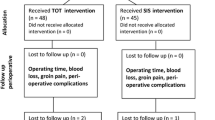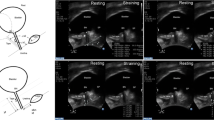Abstract
Introduction and hypothesis
The value of a repeat mid-urethral sling (MUS) after a failed primary sling is not generally accepted. We hypothesize that repeat MUS can be performed with favorable results and acceptable complication rates.
Methods
We reviewed the medical records of 80 women (mean age 62 ± 12.3 years) who underwent repeat MUS surgery from January 2000 to January 2009 at a single tertiary academic centre. Mean follow-up was 44.8 months (range 3–104). Three of these 80 patients were lost to follow-up. Twenty-six (33%) transobturator (TOT), 25 (31%) retropubic (TVT) and 16 (20%) minislings were placed as secondary slings. Thirteen slings (15%) were biological (Pelvicol™). In 4 patients (5%) a release of the primary sling was performed, and in 6 (7.5 %) the extruded sling fragment was totally excised prior to secondary sling placement.
Results
The overall subjective cure rate was 61.0%. Of the study group 74.0% reported subjective improvement. The amounts of pads reduced from a mean of 3.8 pads a day to a mean of 0.75 pads a day postoperatively. The objective cure rate was 63.5%. The incidence of de novo urgency was 8.2% (4 patients). When comparing different secondary sling types no difference was found in the overall continence rate, except for the biological sling. More than half (7 out of 13) of the patients from whom the secondary sling was a biological sling, were not satisfied (p = 0.01). The subjective improvement rates in patients with recurrent or persistent stress urinary incontinence (SUI) were 68.2% and 75.0% respectively. This difference is not statistically significant (p = 0.94). Excision versus release of the MUS showed a slightly higher satisfaction rate after excision, 84.6% and 74.0 % respectively (p = 0.63).
Conclusions
Cure rates and improvement rates of a repeat MUS are favorable and complication rates are acceptable. It should be offered to patients with persistent or recurrent SUI after a failed primary sling, even after previous release or excision.


Similar content being viewed by others
References
Thomas TM, Karran OD, Meade TW (1981) Prevalence of urinary incontinence. Br Med J 281:1243–1245
Ulmsten U, Henriksson L, Johnson P, Varhos G (1996) An ambulatory surgical procedure under local anesthesia for treatment of female urinary incontinence. Int Urogynecol J Pelvic Floor Dysfunct 7:81
Doo CK, Hong B, Chung BJ, Kim JY, Jung HC, Lee KS et al (2006) Five-year outcomes of the tension-free vaginal tape procedure for treatment of female stress urinary incontinence. Eur Urol 50:333
Kuuva N, Nilsson CG (2002) A nationwide analysis of complications associated with the tension-free vaginal tape (TVT) procedure. Acta Obstet Gynecol Scand 81:72–77
Tamussino KF, Hanzal E, Dolle D, Ralph G, Riss PA, Austrian Urogynecology Working Group (2001) Tension-free vaginal tape operation: results of the Austrian registry. Obstet Gynecol 98:732–736
Delorme E (2001) Transobturator urethral suspension: mini-invasive procedure in the treatment of stress urinary incontinence in women. Prog Urol 11:306
de Leval J (2003) Novel surgical technique for the treatment of female stress urinary incontinence: transobturator vaginal tape inside out. Eur Urol 44:724
Novara G, Ficcarra V, Boscolo-Berto R, Secco S, Cavalleri S, Artibani W (2007) Tension-free midurethral slings in the treatment of female stress urinary incontinence: a systematic review and meta-analysis of randomized controlled trials of effectiveness. Eur Urol 52:663–678
Latthe PM, Foon R, Toozs-Hobson P (2007) Transobturator and retropubic tape procedures in stress urinary incontinence: a systematic review and meta-analysis of effectiveness and complications. BJOG 114:522–531
Scarpero HM, Dmochowski RR (2004) Sling failures: what’s next? Curr Urol Rep 5:389
Haylen BT, Freeman RM, Swift SE, Cosson M, Davila GW, Deprest J, Dwyer PL, Fatton B, Kocjancic E, Lee J, Maher C, Petri E, Rizk DE, Sand PK, Schaer GN, Webb R, International Urogynecological Association, International Continence Society, Joint IUGA/ICS Working Group on Complications Terminology (2011) An International Urogynecological Association (IUGA)/International Continence Society (ICS) joint terminology and classification of the complications related directly to the insertion of prostheses (meshes, implants, tapes) and grafts in female pelvic floor surgery. Neurourol Urodyn 30:2–12
Haylen BT, Freeman RM, Swift SE, Cosson M, Davila GW, Deprest J, Dwyer PL, Fatton B, Kocjancic E, Lee J, Maher C, Petri E, Rizk DE, Sand PK, Schaer GN, Webb R, International Urogynecological Association, International Continence Society, Joint IUGA/ICS Working Group on Complications Terminology (2011) An International Urogynecological Association (IUGA)/International Continence Society (ICS) joint terminology and classification of the complications related directly to the insertion of prostheses (meshes, implants, tapes) and grafts in female pelvic floor surgery. Int Urogynecol 22(1):3–15
Haylen BT, de Ridder D, Freeman RM, Swift SE, Berghmans B, Lee J, Monga A, Petri E, Rizk DE, Sand PK, Schaer GN, International Urogynecological Association, International Continence Society (2010) An International Urogynecological Association (IUGA)/International Continence Society (ICS) joint report on the terminology for female pelvic floor dysfunction. Neurourol Urodyn 29:4–20
Haylen BT, de Ridder D, Freeman RM, Swift SE, Berghmans B, Lee J, Monga A, Petri E, Rizk DE, Sand PK, Schaer GN, International Urogynecological Association, International Continence Society (2010) An International Urogynecological Association (IUGA)/International Continence Society (ICS) joint report on the terminology for female pelvic floor dysfunction. Int Urogynecol 21(1):5–26
Riachi L, Kohli N, Miklos J (2002) Repeat tension-free transvaginal tape (TVT) sling for the treatment of recurrent stress urinary incontinence. Int Urogynecol J Pelvic Floor Dysfunct 13:133–135
Comiter GV (2006) Surgery insight: management of failed sling surgery for female stress urinary incontinence. Nat Clin Prac Urol 2:666–674
Liapis A, Bakas P, Creatsas G (2009) Tension-free vaginal tape in the management of recurrent urodynamic stress incontinence after previous failed midurethral tape. Eur Urol 55:1450–1458
Stav K, Dwyer PL, Rosamilia A, Schierlitz L, Lim YN, Chao F, De Souza A et al (2010) Repeat synthetic mid urethral sling procedure for women with recurrent stress urinary incontinence. J Urol 183:241–246
Lee KS, Doo CK, Han DH, Jung BJ, Han J, Choo M (2007) Outcomes following repeat mid urethral synthetic sling after failure of the initial sling procedure: rediscovery of the tension-free vaginal tape procedure. J Urol 178:1370–1374
Abdel-Fattah M, Ramsay I, Pringle S, Hardwick C, Ali H, Young D, Mostafa A (2011) Evaluation of transobturator tension-free vaginal tapes in management of women with recurrent stress urinary incontinence. J Urol 77:1070–1075
Tsivian A, Neuman M, Yulish E et al (2007) Redo midurethral synthetic sling for female stress urinary incontinence. Int Urogynecol J Pelvic Floor Dysfunct 18:23
Smith ARD, Chang D, Dmochowski R (2009) Surgery for urinary incontinence in women. In: Abrams P, Cardozo L, Khoury S, Wein A (eds) Incontinence, 4th International Consultation on Incontinence. Editions 21, Paris, pp 1235
Acknowledgements
None
Financial disclaimer
None.
Conflicts of interest
None.
Author information
Authors and Affiliations
Corresponding author
Rights and permissions
About this article
Cite this article
Verbrugghe, A., De Ridder, D. & Van der Aa, F. A repeat mid-urethral sling as valuable treatment for persistent or recurrent stress urinary incontinence. Int Urogynecol J 24, 999–1004 (2013). https://doi.org/10.1007/s00192-012-1971-0
Received:
Accepted:
Published:
Issue Date:
DOI: https://doi.org/10.1007/s00192-012-1971-0




